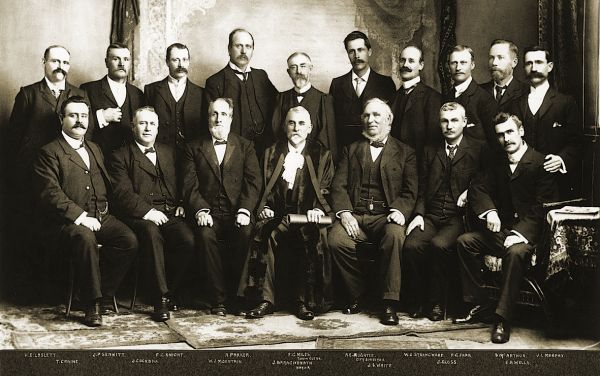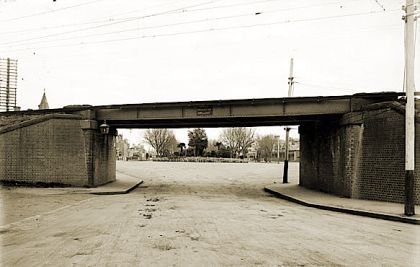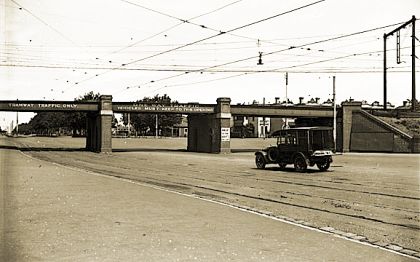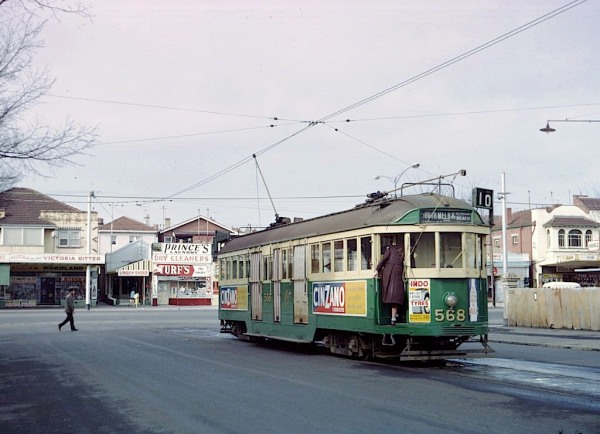Melbourne Tram Museum
- Follow Melbourne Tram Museum on Twitter
- Follow Melbourne Tram Museum on Facebook
- Follow Melbourne Tram Museum on Instagram
- Follow Melbourne Tram Museum on Pinterest
- Follow Melbourne Tram Museum on Tumblr
- Subscribe to Melbourne Tram Museum's RSS feed
- Email Melbourne Tram Museum
Risky business: building South Melbourne’s first electric tramway
An early project of the Melbourne and Metropolitan Tramways Board (M&MTB) was the building of an electric tramway through South Melbourne and Middle Park to the junction of Fitzroy Street and The Esplanade, St Kilda. It was a new route not previously serviced by a tramway. Construction commenced in early 1925 with tram services officially opened on 30 October of that year.
While it was the M&MTB that built the new tramway, it had been planned much earlier by the City of South Melbourne – and approved for construction by 1914, five years before the founding of the M&MTB. Why wasn't it built a decade earlier?
Overcrowding
By 1891 the City of South Melbourne was home to 41,000 people and was Melbourne’s second most populous municipality after the City of Melbourne. It stretched from the Yarra River docks and nearby industrial areas to southern residential suburbs.
Mass public transport was provided by the Melbourne to St Kilda Railway (from 1857) and the city to South Melbourne cable tram (from 1890). By the late 1890s calls for more services were common in newspapers. Residents also petitioned the city council to address the overcrowding on trains and trams experienced by peak-hour travellers and Sunday beachgoers. Council negotiations with the Victorian Railways and the Melbourne Tram and Omnibus Company (MTOC), operators of the cable trams, brought no improvements.
Soon vocal residents and councillors talked of building their own electric tramway, encouraged by similar proposals in other municipalities.

South Melbourne cable tram in Bridport Street, Albert Park with the St Kilda railway level crossing in the background (c1920).- Photograph courtesy State Library of Victoria.
Proposed routes
As the residential areas of Middle Park and the industrial areas of the north-east were not well served by the railway or the cable tram, Danks Street and Sturt Street became the route preferred by tramway advocates and the South Melbourne Council. This would avoid the streets with established cable tramways but still allow passengers to transfer between cable and electric trams.
Beaconsfield Parade was not included in the proposal because of recent expensive beautification works along the foreshore and the supposed danger to young beachgoers. The Danks Street route avoided this and would provide a wider passenger catchment. The new tramway would pass under the St Kilda Railway at the Kerferd Road bridge, which would require the widening of the underpass and a slight raising of the bridge.
Several connections with other municipalities were discussed to benefit travellers and to generate revenue. Serious consideration was given to a southern extension into St Kilda, via Beaconsfield Parade and Acland Street to connect with the Prahran and Malvern Tramways Trust (PMTT) line in Carlisle Street.
Less popular proposals were for a line around the southern edge of Albert Park Lake to High Street, Prahran, or around the northern edge of the lake along Albert Road and Queens Road to Commercial Road, Prahran. There were also proposals to connect with the Hawthorn Tramways Trust line in Batman Avenue and to build a line through the Port Melbourne docks to Williamstown. Some of these proposals were later included in the M&MTB’s 1923 General Scheme which canvassed the expansion of the tramway network.
In 1912 Councillor West Strangward (1870-1929) of the City of South Melbourne submitted a proposal to the Parliamentary Standing Committee on Railways to build the council’s preferred route. He noted, “The proposed line would serve to line up communication between Middle Park and the rest of South Melbourne, which is not at present provided for.”
Cr Strangward was a long-term councillor, an accountant and a member of several tramway authorities, including secretary of the PMTT. In future years he would become secretary of the M&MTB.
 Map of Cr Strangward’s proposed electric tramway. Note the use
of Kerferd Road and the terminus at Fraser Street, South Melbourne’s
southern boundary.
Map of Cr Strangward’s proposed electric tramway. Note the use
of Kerferd Road and the terminus at Fraser Street, South Melbourne’s
southern boundary.- Map from Emerald Hill Record (13 July 1912).
Construction approved
The railway committee supported Strangward’s proposal and noted the council’s hope that an extension into another municipality might be possible in the future.
In 1913 the City of South Melbourne commissioned McCarty, Underwood & Co Electrical Engineers to examine the engineering and financial details. They also supported the same route, costing it just under £64,000 ($7.8 million in 2018 dollars), including a car depot in Sturt Street and ten drop-end single truck cars like those of the PMTT.
In 1914 the South Melbourne Tramways Act was passed by State Parliament authorising construction of the tramway and the borrowing of £64,000 to fund it. The State Government was authorising other municipal tramways at the same time to address demands for more public transport while avoiding increased expense to the state budget.
Councillors divided
Tramway issues had been a topic of debate among councillors for years. When authority to construct the tramway was received, voices of dissent within South Melbourne Council and among ratepayers grew louder. Two reports were soon to back those worried about the financial risk of building the tramway.
In July 1914 the Parliamentary Standing Committee on Railways recommended against the proposed extension into St Kilda via Acland Street to Carlisle Street and the PMTT line. The extension would increase passenger numbers and revenue for South Melbourne, but duplicate existing lines and not benefit St Kilda. The committee also recommended against a shorter extension to Fitzroy Street that would bring little benefit to St Kilda.
In 1915 the PMTT was commissioned to review the financial viability of seven electric tramways proposed in various parts of Melbourne. The report was signed by its chairman, Alex Cameron, and its engineer and manager, H S Dix.
In reference to the proposed South Melbourne line, the report noted that its viability depended on connection to PMTT lines in Commercial Road or Carlisle Street and that the estimated costs had increased to £74,000, which South Melbourne Council would need to fund. Also it noted that the shortage of materials during World War I (WWI) and the upcoming electrification of the railways could adversely affect tramways. The chairman concluded, “Should the Trust’s tramways be extended into municipalities outside the boundaries of the municipalities having representation on the Trust, such municipalities should join the Trust, and assume liability for its indebtedness…”
Following these two cautionary reports, and apprehension about sharing the tramway debts of other municipalities, a significant minority of councillors proposed waiting for the formation of a Melbourne-wide tramway authority.
A prominent member on the delaying side was Cr John Baragwanath JP (1856-1943). He was a long-term councillor, a four-time mayor and also a member of the council’s tramway committee. He quoted the losses suffered by the Footscray Tramways Trust and the Caulfield Council and was critical of the state government shifting costs onto municipalities. Supporting him was Cr Thomas Craine JP (1863-1940), a three-time mayor and councillor for 41 years.
Despite the weight of criticism, many councillors remained in favour, persuaded by the daily travel difficulties of residents. As noted above, Cr West Strangward was one who held these views. With him was Cr Donald McArthur JP (1855-1924), also a long-term councillor, a two-time mayor and a long-term chairman of the tramways committee. He consistently advocated for a municipal tramway as a community amenity.

South Melbourne City Councillors, 1904. Nine of these councillors were still in office in 1914 when the tramway was legislated. These included Cr Strangward and Cr McArthur (standing fourth & second from right) and Cr Craine and Cr Baragwanath (seated far left and centre, mayor).- Photograph courtesy Port Phillip City Collection.
Considerable support for the tramway continued through the war years. Upon expiration of the original 1914 loan authorisation, in 1917 the council successfully applied for an extension. But as in the past, a loan for the approved amount was not negotiated.
M&MTB slow to act
At the end of WWI, the Melbourne and Metropolitan Tramways Act (1918) was passed by Parliament, authorising the M&MTB to be formed and take over the city’s tramways. The Act listed the South Melbourne tramway as an already legislated tramway, so many South Melbourne residents expected that its construction would soon begin. But as they were to realise, this new Melbourne-wide authority had broader responsibilities and South Melbourne was just one of many municipalities calling for state-funded tramways.
In November 1919, the M&MTB was inaugurated with Alex Cameron of the PMTT as its first chairman. Within days the South Melbourne mayor and three councillors met with Chairman Cameron to put their case for immediate construction of the South Melbourne line. The mayor noted, “Owing to the war and the consequent high price of material, it was found impossible by the council to construct the line on the money provided for in the Act (£64,000). The Board, however, is not bound by any such amount, and the council now asks that [it be] one of the first tram[ways] to be constructed.”
The M&MTB chairman explained that time was needed to first take control of Melbourne’s tramways and to look at the question of new constructions. Nevertheless, he thought that the South Melbourne tramway would be one of the first to be built.
Two years passed with no commencement of work. By late 1921 overcrowding on existing transport had worsened and agitation from ratepayers, business owners and the media was directed at the council. Relations between some councillors and the M&MTB chairman were strained.
In October 1922 a large delegation of South Melbourne councillors, community representatives and businessmen met with Chairman Cameron to press their case – even proposing the interim building of the southern half of the electric tram route to feed the cable trams. The chairman responded that the South Melbourne line could not be financed as a stand-alone service. It had to be part of a network. In addition, new tramcar construction was delayed by a shortage of suitable timber and the cost of the tramway was now budgeted at £200,000, more than triple the original estimate.
In February 1923 Chairman Cameron reported to the Standing Committee on Railways that there was considerable pressure from local councils but that he “relied on the Board’s courage to resist undue pressure”. He noted that any new construction was dependent on available funds and its place in the Melbourne-wide plan.
As the number of motor buses imported to Melbourne increased, private bus companies introduced services into parts of South Melbourne. By May 1924 a bus service was following the cable tram route from the city to South Melbourne. However these heavy buses with solid rubber tyres damaged the roads, requiring the council to pay for expensive repairs. Those councillors supporting the tramway construction held that early completion of the government tramway would not only prevent bus damage to their roads, but permanently remove from the council financial responsibility for the centre section of roads controlled by the tramways.
Kerferd Road bridge
By 1924 the Kerferd Road railway bridge had become a key concern for the M&MTB. The bridge was too low and narrow to allow a tram to pass under it, and it had also become a road traffic bottleneck due to the increasing number of motor vehicles on the road. Alterations to the bridge would be required to permit construction of the tramway.
 Kerferd Road bridge before alterations were made in 1925.
Kerferd Road bridge before alterations were made in 1925.- Photograph courtesy Public Record Office Victoria.
The Victorian Railways refused to contribute to construction costs for the bridge alterations, citing the difficulty of raising the bridge so close to Albert Park Station. The M&MTB requested that South Melbourne fund the full cost of the upgrade, estimated at £20,000. This outraged some ratepayers and councillors, who argued it would be a waste of the municipality’s money as the railway and bus services were perfectly adequate, and the proposed tramway would never cover its operating costs.
In the absence of a funding agreement, the M&MTB then advised it too was considering running motor buses on the route for several years to delay the need for the bridge upgrade. Debate continued regarding the comparative cost of repairing bus-damaged roads on an ongoing basis, as against a one-off bridge upgrade. Then the M&MTB proposed that South Melbourne fund only half the cost. The council eventually accepted the proposal, with its contribution totalling just £7000.
In August 1924 the M&MTB gained authorisation to vary the original route by using Mills Street rather than Kerferd Road to avoid interference with the Kerferd Road central reservation. This would also increase its distance from the Victoria Avenue cable tramway, thus broadening its passenger catchment. A spur line would be built along Mills Street to Beaconsfield Parade for the layover of football trams during VFL games at the Lakeside Oval. In addition, the line would be extended to Fitzroy Street and The Esplanade, St Kilda, for connection with the soon to be converted St Kilda Beach cable tramway.
Plans also included the construction of a tram depot in Hanna Street (now Kings Way) between Dorcas Street and Bank Street with space for its enlargement.
Construction
In January 1925, the tender for constructing the permanent way was awarded to the Foundation Company of London for £56,247. Chairman Cameron defended the choice of an overseas company rather than a local firm because it was the cheapest quote and construction would start immediately.

Construction of the electric tramway in Sturt Street immediately south of City Road (1925). On the left is Wirth’s Olympia recreational park where the Arts Centre Melbourne now stands.- Photograph courtesy State Library of Victoria.
The Foundation Company was also awarded the contract to replace the St Kilda Road cable tramway with electric track for £144,800. Numerous photos of both projects are now held by State Library Victoria, some prominently displaying the company’s name. A workers’ dispute arose in June 1925 when the union was refused the right to attend work sites to encourage union membership. The dispute was quickly resolved in discussions between the company’s managing director and Trades Hall representatives.

Intersection of City Road and Sturt Street with the new YMCA building in the background (late 1925). Q class 144 waits at the original terminus before turning left into Sturt Street bound for Fitzroy Street and The Esplanade, St Kilda Beach. The connecting track to Princes Bridge is under construction.- Photograph courtesy State Library of Victoria.
While track laying at either end of the route advanced quickly, it was not until October 1925 that the major alterations to the Kerferd Road bridge began. The bridge was raised slightly and widened from one to three spans by using six 12 metre girders. In what appears to have been a cooperative effort by railway and tramway crews, the girders were moved into position in the early hours of three consecutive Sunday mornings thus avoiding interruption to train services.
 Kerferd Road bridge after the widening of the underpass and construction
of the tramway.
Kerferd Road bridge after the widening of the underpass and construction
of the tramway. - Photograph courtesy Public Record Office Victoria.
The tram line from the corner of Fitzroy Street and The Esplanade, St Kilda to the corner of City Road and St Kilda Road was officially opened on 30 October 1925. By March 1926, an electric tramway had replaced the cable tramway across Princes Bridge and along Swanston Street. This allowed the through-routing of services from Fitzroy Street to East and West Preston via Lygon Street, Brunswick Road, Holden Street and St Georges Road.
It had taken over a decade, but the residents and businesses of South Melbourne and Middle Park finally got their electric tramway. It came without the financial risk of large loans for the council, requiring only the relatively small municipal contribution of £7,000. The tramway vision of many councillors and residents had been realised. Today this tramway still operates, albeit with several changes to the original 1926 route.

A segment of an early 1930s M&MTB map. The red lines indicate electric tramways including the Sturt Street-Danks Street line to Fitzroy Street. The green lines indicate cable tramways including those to South Melbourne and Port Melbourne that operated until 1937. Not shown are the Hanna Street Depot just south of Sturt Street or the access track to the Domain Road/St Kilda Road intersection.- Map courtesy State Library of Victoria.

W2 546 waits at the original terminus in Beaconsfield Parade at Fitzroy St, St Kilda (1930s).- Photograph courtesy Public Record Office Victoria.
Route changes
1930: |
Services from the corner of Fitzroy Street and The Esplanade into Swanston Street were rerouted to East Coburg. This followed the electrification of Collins Street and Brunswick Street, Fitzroy, which provided East and West Preston trams with a new route to the city. |
1937: |
The South Melbourne cable tramway was replaced with an electric tramway and its route modified to use Spencer Street and Collins Street, then via Brunswick Street, Fitzroy, to East and West Preston. |
1953: |
Alterations were made to routes travelling through the intersection at Park Street and Clarendon Street, South Melbourne. Trams from Fitzroy Street and The Esplanade were redirected straight through the intersection to Spencer Street and Collins Street then on to East and West Preston. Trams from South Melbourne Beach were redirected straight through the intersection to Sturt Street and Swanston Street then on to East Coburg. |
1959: |
The Beaconsfield Parade terminus was abandoned due to traffic congestion and a new terminus built in Park Street, St Kilda at Fitzroy Street without connecting track between the two lines. A single-track connection was added in 1995. |
1970: |
Track in City Road and the northern part of Sturt Street was abandoned to allow construction of the Arts Centre Melbourne. It was replaced with track along Nolan Street (now Southbank Boulevard). |

W2 568 waits at the new terminus in Park Street at Fitzroy Street, St Kilda, 1965.- Photograph courtesy Mal Rowe
Notes
This is an expanded version of an article originally published in The Bellcord No 35 (September 2017).
Financial data has been converted to 2018 Australian dollars using the inflation calculator from the Reserve Bank of Australia.
Bibliography
McCarty Underwood and Co (1913) Report upon the Proposed Electric Tramway for the City of South Melbourne, August 1913, Emerald Hill Library and Heritage Centre
Melbourne and Metropolitan Tramways Act (1918)
Prahran and Malvern Tramways Trust (1915) Proposed New Tramway Lines, Upon which the Trust has been asked to Report, August 1915, Melbourne Tram Museum
Record (1908) South Melbourne Improvements, To The Editor, 24 October 1908, page 2
Record (1912) Electric Tramway, Cr W O Strangward’s Proposal, 29 June 1912, page 5
Record (1912) Proposed electric Tramway, Evidence before Railway Standing Committee, 30 November 1912, page 3
Record (1913) South Melbourne City Council, 1 November 1913, page 2
Record (1914) Tramway To Middle Park, Council Decide to Float a Loan, Saturday 7 March 1914, page 3
Record (1914) Tramway Through Park, St Kilda’s Position, 7 November 1914, page 2
Record (1915) Tramway Through Albert Park, 10 July 1915, page 3
Record (1917) Tramway Proposal, Middle Park Residents Must Wait, 3 February 1917, page 3
Record (1917) Proposed Tramway, Princes Bridge to Middle Park, 9 June 1917, page 2
Record (1917) State Elections, Mr J Baragwanath Opens His Campaign, 3 November 1917, page 2
Record (1919) South Melbourne Electric Trams, Deputation Of Councillors Waits on Tramway Board Chairman, 22 November 1919, page 2
Record (1921) No Relief for Tram Travellers, Repeated Agitation Necessary, 26 November 1921, page 1
Record (1922) A Divided Council, Evil Effects of Party Politics, 1 July 1922, page 1
Record (1922) Motor Buses, South Melbourne Proposal, 30 September 1922, page 1
Record (1922) Trams to Middle Park, Tramway Board’s Distinct Promise, 21 October 1922, page 1
Record (1922) Improved Tram Services, Effect of Threatening Competition, 28 October 1922, page 1
Record (1923) Tramway Board’s Failure, 21 April 1923, page 4
Record (1924) Why the Buses Came, 1 March 1924, page 4
Record (1924) South Motor Buses, Following Tramway Route, 31 May 1924, page 6
Record (1924) Enlarging Kerford Rd Subway, Tram Board Asks Council for £10,000, 28 June 1924, page 4
Record (1924), Middle Park Tramway, 28 June 1924, page 4
Record (1924) Tramway to Middle Park, Council Votes £10,000, 12 July 1924, page 4
Record (1925) New Electric Tramway. Tender Let To English Firm. 31 January 1925, page 6
Record (1925) Kerferd Road Bridge, 31 October 1925, page 7
South Melbourne Loan Act (1914)
South Melbourne Tramways Act (1914)
The Age (1921) South Melbourne Tram Service, Tramways Chairman replies to Mayor Craine, 2 December 1921, page 9
The Age (1922) City Transport problem, Motor buses as Auxiliaries, 29 September 1922, page 9
The Age (1923) Tramway Extensions, Conversion of the Cable System, 2 February 1923, page 11
The Age (1924) New Electric Tramway, The Line to South Melbourne, 5 January 1924, page 13
The Age (1924) Trams And Buses, Deviation of Route Approved, 19 August 1924, page 10
The Age (1925) South Melbourne Electric Tramway, 1 May 1925, page 18
The Argus (1911) The Rush Home, Standing Room Only, 14 June 1911, page 11
The Argus (1913) Trams To The Beach, Prahran Councillors Angry, 6 May 1913, page 8
The Argus (1913) Suburban Tramways, South Melbourne to Kew, 28 October 1913, page 6
The Argus (1925) Tramway Conversion, St Kilda Rd Project, 7 August 1925, page 12
The Argus (1925) New St Kilda Tramway, Opening Ceremony Today, 30 October 1925, page 10
The Argus (1925) To Accommodate St Kilda Electric Trams, 11 December 1925, page 17
Acknowledgements
My thanks to the Emerald Hill Library and Heritage Centre and Middle Park History Group for their assistance.